目录
首先我们要先对Matlab这款软件的画图功能给予肯定,画图功能太强大了,所以其也被广泛的应用到绘制图形,Matlab的画图功能有以下几个优点:
- 简单易用:提供了简洁的绘图接口
- 多样性:支持绘制各种类型的图形
- 灵活性:提供了丰富的图形参数和功能
- 交互性:可以通过鼠标交互式的探索和操作图形
- 高质量输出:绘制的图形具有较高的质量
来,我们开整!!!
1.plot()函数
语法1:
plot(x,y)%创建y中数据对x中对应值的二维线图- 要绘制由线段连接的一组坐标,请将x和y指定为相同长度的向量
- 要将同一组坐标上绘制多组坐标,请将x或y中的至少一个指定为矩阵
>> x=0:pi/10:2*pi;
>> y=sin(x);
>> plot(x,y)
语法2:
plot(y)%绘制y对一组隐式x的坐标- 如果y是向量,则x的坐标范围从1到length(y)
- 如果y是矩阵,则对于y中的每个列,图中包含一个对应的行
plot(cos(0:pi/20:2*pi))
语法三:
plot(y,Linespec)%使用隐式x的坐标绘制y,并指定线型、标记和颜色>> x=0:pi/10:2*pi;
>> y=sin(x);
>> plot(y,'or:')
2. hold(添加新绘图是否保留旧绘图)
hold on: 添加新绘图时保留旧绘图,新绘图基于坐标区的 ColorOrder 和 LineStyleOrder 属性使用后续的颜色和线型。
hold off(默认): 将保留状态设置为off,添加新绘图时,不会保留旧绘图,新添加到坐标区中的绘图清除现有绘图并重置所有的坐标区属性
我们现在单画一个图示例:
>> plot(y,'or:');
>> plot(cos(0:pi/20:2*pi))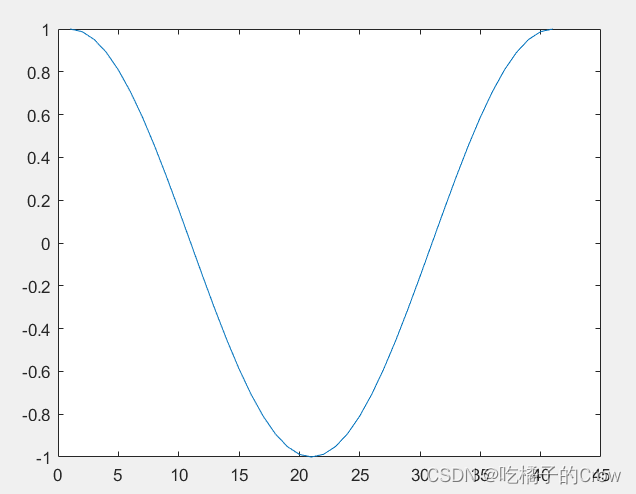
因为我们这个时候hold还是处于默认关闭状态,所以我们不能将两个图在一张画布上进行呈现,当我们打开后
>> hold on我们再运行上述代码,就会发现已经可以按照我们的预期呈现出来了
>> plot(y,'or:');
>> plot(cos(0:pi/20:2*pi))
3. Plot Style
使用str中定义的格式绘制每个向量对(x,y)
3.1 线型

3.2 标记

3.3 颜色
4. legend()
在我们画图中的过程中,因为一块画布上我们 需要画很多个图形,那么怎么识别哪个图形是哪个函数的呢?legend()函数就完美解决了这个问题
>> x=0:0.5:4*pi;
y=sin(x); h=cos(x); w=1./(1+exp(-x));
g=(1/(2*pi*2)^0.5).*exp((-1.*(x-2*pi).^2)./(2*2^2));
plot(x,y,'bd-',x,h,'gp:',x,w,'ro-',x,g,'c^-');
当我们加上legend()之后:
legend('sin(x)','cos(x)','Sigmoid','Gauss function');
5.X 、Y and Title?
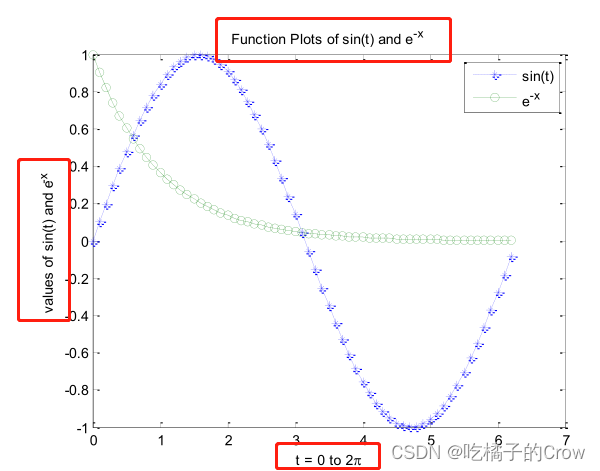
在画图中x轴、y轴和图名我们应该怎么去设置呢?
title()%标题
xlabel()%x坐标
ylabel()%y坐标
zlabel()%z坐标x = 0:0.1:2*pi; y1 = sin(x); y2 = exp(-x);
plot(x, y1, '--*', x, y2, ':o');
xlabel('t = 0 to 2\pi');%2π=2\pi
ylabel('values of sin(t) and e^{-x}')%e^-x =e^{-x}
title('Function Plots of sin(t) and e^{-x}');
legend('sin(t)','e^{-x}');
6. Text()和annotation()
文本与数学表达式使用的是LaTex,它是一种专业的排版系统,其优点是:
- 专业的排版质量:LaTeX以其卓越的排版能力而闻名,通过使用LaTeX,用户可以创建高质量、格式美观的文档,自动处理字体样式、大小、段落布局、数学公式、引用等排版细节。
- 数学公式排版:LaTeX是科学和数学排版的首选工具,在排版复杂的数学公式和符号方面有着出色的表现。它提供了丰富的数学环境和符号库,使输入和排版数学公式更加容易。
- 逻辑结构化:LaTeX允许将文档轻松划分为章节,自动生成目录和页眉/页脚,便于管理大型文档。另外,结构化的章节划分可以提高文档的可读性和可维护性。
- 版本控制和协作:LaTeX文档本质上是纯文本文件,可与版本控制系统(如Git)集成,进行版本管理和协作编辑。这对于团队协作和多作者文档编写非常有用。
- 跨平台兼容性:基于TeX的LaTeX几乎可以在所有操作系统上运行,包括Windows、Mac和Linux。这使得轻易在不同操作系统上协作或分享LaTeX文档成为可能。

我们如果利用LaTeX去生成这么一个定积分式子?
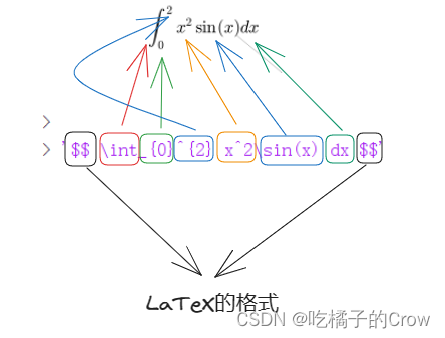
x = linspace(0,3); y = x.^2.*sin(x); plot(x,y);
line([2,2],[0,2^2*sin(2)]);
str = '$$ \int_{0}^{2} x^2\sin(x) dx $$';
text(0.25,2.5,str,'Interpreter','latex');%(0.25,2.5)文本出现的位置
annotation('arrow','X',[0.32,0.5],'Y',[0.6,0.4]);%[0.32,0.5]x坐标从整个图形32%的地方到50%的地方(左->右) [0.6,0.4]y坐标从60%的地方到40%的地方(上->下)
7.line(创建基本线条)
7.1 基本语法
语法1:
line(x,y) line(x,y) 使用向量 x 和 y 中的数据在当前坐标区中绘制线条。如果 x 和 y 中有一个是矩阵或两者都是矩阵,则 line 将绘制多个线条。与 plot 函数不同,line 会向当前坐标区添加线条,而不删除其他图形对象或重置坐标区属性
- 使用向量数据绘制线条
%以向量的形式创建x、y,然后绘制y对x的图
x = linspace(0,10);
y = sin(x);
line(x,y)
- 使用矩阵数据绘制多个线条
%通过将 x 和 y 指定为矩阵来绘制两个线条。使用 line 绘制 y 的列对 x 的列的单独线条。
x = linspace(0,10)';
y = [sin(x) cos(x)];
line(x,y)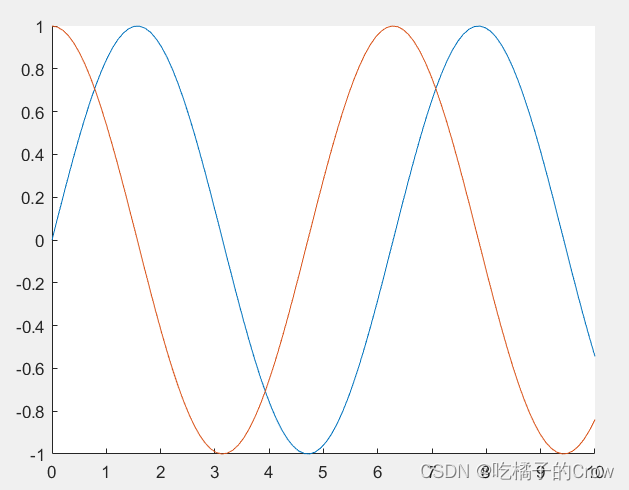
语法2:
line(x,y,z) 在三维坐标中绘制线条。%通过指定 x、y 和 z 的值,在三维坐标中绘制线条。使用 view(3) 将坐标区更改为三维视图。
t = linspace(0,10*pi,200);
x = sin(t);
y = cos(t);
z = t;
line(x,y,z)
view(3)
7.2 指定线条属性
我们想给绘制的线段加点颜色以及形状应该怎么操作?
在点 (1,2) 和 (9,12) 之间绘制一条红色虚线。将
Color和LineStyle属性设置为名称-值对组。
x = [1 9];
y = [2 12];
line(x,y,'Color','red','LineStyle','--')
7.3 更改线条属性
x = [3 2];
y = [15 12];
pl = line(x,y);
pl.Color = 'green';
pl.LineStyle = '--';
8.图像属性
图形对象(万物皆可对象),图形是由许多物体组成的

我们可以直接在图形界面进行查看:
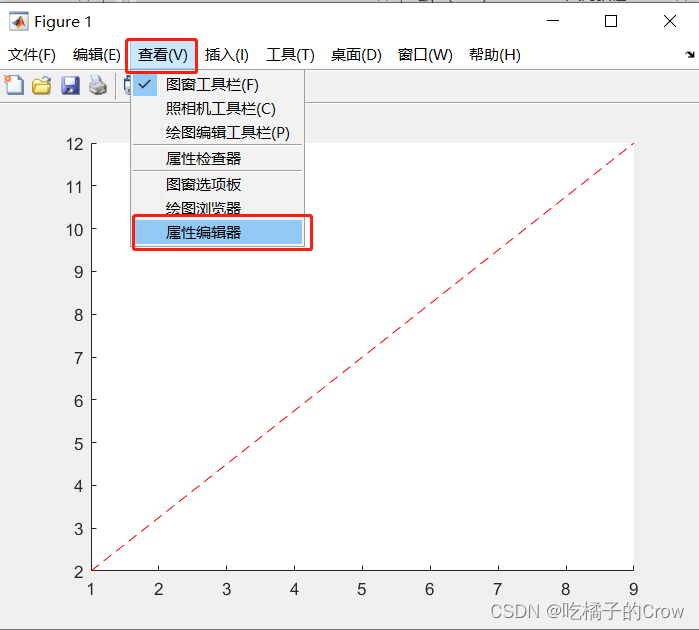

一个图像有这么多属性,我们如何去修改其属性,使得图像变得更加具有观赏性呢?

gca:ax = gca 返回当前图窗中的当前坐标区(或独立可视化)。使用 ax 获取和设置当前坐标区的属性。如果当前图窗中没有坐标区或图,则 gca 会创建一个笛卡尔坐标区对象。
gcf:fig = gcfgcf 将创建一个图窗并返回其句柄。可以使用图窗句柄查询和修改图窗的属性。
8.1 获取对象属性
获取图形对象的属性:get()
>> x = linspace(0, 2*pi, 1000);
y = sin(x); h = plot(x,y);
获得h的属性:
>> get(h)
AlignVertexCenters: 'off'
Annotation: [1×1 matlab.graphics.eventdata.Annotation]
BeingDeleted: 'off'
BusyAction: 'queue'
ButtonDownFcn: ''
Children: [0×0 GraphicsPlaceholder]
Clipping: 'on'
Color: [0 0.4470 0.7410]
ColorMode: 'auto'
CreateFcn: ''
DataTipTemplate: [1×1 matlab.graphics.datatip.DataTipTemplate]
DeleteFcn: ''
DisplayName: ''
HandleVisibility: 'on'
HitTest: 'on'
Interruptible: 'on'
LineJoin: 'round'
LineStyle: '-'
LineStyleMode: 'auto'
LineWidth: 0.5000
Marker: 'none'
MarkerEdgeColor: 'auto'
MarkerFaceColor: 'none'
MarkerIndices: [1×1000 uint64]
MarkerMode: 'auto'
MarkerSize: 6
Parent: [1×1 Axes]
PickableParts: 'visible'
Selected: 'off'
SelectionHighlight: 'on'
Tag: ''
Type: 'line'
UIContextMenu: [0×0 GraphicsPlaceholder]
UserData: []
Visible: 'on'
XData: [1×1000 double]
XDataMode: 'manual'
XDataSource: ''
YData: [1×1000 double]
YDataSource: ''
ZData: [1×0 double]
ZDataSource: ''获得坐标轴的属性:
>> get(gca)
ALim: [0 1]
ALimMode: 'auto'
ActivePositionProperty: 'outerposition'
AlphaScale: 'linear'
Alphamap: [1×64 double]
AmbientLightColor: [1 1 1]
BeingDeleted: 'off'
Box: 'on'
BoxStyle: 'back'
BusyAction: 'queue'
ButtonDownFcn: ''
CLim: [0 1]
CLimMode: 'auto'
CameraPosition: [3.5000 0 17.3205]
CameraPositionMode: 'auto'
CameraTarget: [3.5000 0 0]
CameraTargetMode: 'auto'
CameraUpVector: [0 1 0]
CameraUpVectorMode: 'auto'
CameraViewAngle: 6.6086
CameraViewAngleMode: 'auto'
Children: [1×1 Line]
Clipping: 'on'
ClippingStyle: '3dbox'
Color: [1 1 1]
ColorOrder: [7×3 double]
ColorOrderIndex: 2
ColorScale: 'linear'
Colormap: [256×3 double]
CreateFcn: ''
CurrentPoint: [2×3 double]
DataAspectRatio: [3.5000 1 1]
DataAspectRatioMode: 'auto'
DeleteFcn: ''
FontAngle: 'normal'
FontName: 'Helvetica'
FontSize: 10
FontSizeMode: 'auto'
FontSmoothing: 'on'
FontUnits: 'points'
FontWeight: 'normal'
GridAlpha: 0.1500
GridAlphaMode: 'auto'
GridColor: [0.1500 0.1500 0.1500]
GridColorMode: 'auto'
GridLineStyle: '-'
HandleVisibility: 'on'
HitTest: 'on'
Interactions: [1×1 matlab.graphics.interaction.interface.DefaultAxesInteractionSet]
Interruptible: 'on'
LabelFontSizeMultiplier: 1.1000
Layer: 'bottom'
Layout: [0×0 matlab.ui.layout.LayoutOptions]
Legend: [0×0 GraphicsPlaceholder]
LineStyleOrder: '-'
LineStyleOrderIndex: 1
LineWidth: 0.5000
MinorGridAlpha: 0.2500
MinorGridAlphaMode: 'auto'
MinorGridColor: [0.1000 0.1000 0.1000]
MinorGridColorMode: 'auto'
MinorGridLineStyle: ':'
NextPlot: 'replace'
OuterPosition: [0 0 1 1]
Parent: [1×1 Figure]
PickableParts: 'visible'
PlotBoxAspectRatio: [1 0.7882 0.7882]
PlotBoxAspectRatioMode: 'auto'
Position: [0.1300 0.1100 0.7750 0.8150]
Projection: 'orthographic'
Selected: 'off'
SelectionHighlight: 'on'
SortMethod: 'childorder'
Tag: ''
TickDir: 'in'
TickDirMode: 'auto'
TickLabelInterpreter: 'tex'
TickLength: [0.0100 0.0250]
TightInset: [0.0510 0.0527 0.0071 0.0200]
Title: [1×1 Text]
TitleFontSizeMultiplier: 1.1000
TitleFontWeight: 'normal'
Toolbar: [1×1 AxesToolbar]
Type: 'axes'
UIContextMenu: [0×0 GraphicsPlaceholder]
Units: 'normalized'
UserData: []
View: [0 90]
Visible: 'on'
XAxis: [1×1 NumericRuler]
XAxisLocation: 'bottom'
XColor: [0.1500 0.1500 0.1500]
XColorMode: 'auto'
XDir: 'normal'
XGrid: 'off'
XLabel: [1×1 Text]
XLim: [0 7]
XLimMode: 'auto'
XMinorGrid: 'off'
XMinorTick: 'off'
XScale: 'linear'
XTick: [0 1 2 3 4 5 6 7]
XTickLabel: {8×1 cell}
XTickLabelMode: 'auto'
XTickLabelRotation: 0
XTickMode: 'auto'
YAxis: [1×1 NumericRuler]
YAxisLocation: 'left'
YColor: [0.1500 0.1500 0.1500]
YColorMode: 'auto'
YDir: 'normal'
YGrid: 'off'
YLabel: [1×1 Text]
YLim: [-1 1]
YLimMode: 'auto'
YMinorGrid: 'off'
YMinorTick: 'off'
YScale: 'linear'
YTick: [-1 -0.8000 -0.6000 -0.4000 -0.2000 0 0.2000 0.4000 0.6000 0.8000 1]
YTickLabel: {11×1 cell}
YTickLabelMode: 'auto'
YTickLabelRotation: 0
YTickMode: 'auto'
ZAxis: [1×1 NumericRuler]
ZColor: [0.1500 0.1500 0.1500]
ZColorMode: 'auto'
ZDir: 'normal'
ZGrid: 'off'
ZLabel: [1×1 Text]
ZLim: [-1 1]
ZLimMode: 'auto'
ZMinorGrid: 'off'
ZMinorTick: 'off'
ZScale: 'linear'
ZTick: [-1 0 1]
ZTickLabel: ''
ZTickLabelMode: 'auto'
ZTickLabelRotation: 0
ZTickMode: 'auto'获得当前图窗的属性:
>> get(gcf)
Alphamap: [1×64 double]
BeingDeleted: 'off'
BusyAction: 'queue'
ButtonDownFcn: ''
Children: [1×1 Axes]
Clipping: 'on'
CloseRequestFcn: 'closereq'
Color: [0.9400 0.9400 0.9400]
Colormap: [256×3 double]
CreateFcn: ''
CurrentAxes: [1×1 Axes]
CurrentCharacter: ''
CurrentObject: [0×0 GraphicsPlaceholder]
CurrentPoint: [0 0]
DeleteFcn: ''
DockControls: 'on'
FileName: ''
GraphicsSmoothing: 'on'
HandleVisibility: 'on'
InnerPosition: [851.4000 158.6000 560 420]
IntegerHandle: 'on'
Interruptible: 'on'
InvertHardcopy: 'on'
KeyPressFcn: ''
KeyReleaseFcn: ''
MenuBar: 'figure'
Name: ''
NextPlot: 'add'
Number: 1
NumberTitle: 'on'
OuterPosition: [844.2000 151.4000 574.4000 508.8000]
PaperOrientation: 'portrait'
PaperPosition: [3.0917 9.2937 14.8167 11.1125]
PaperPositionMode: 'auto'
PaperSize: [21.0000 29.7000]
PaperType: 'A4'
PaperUnits: 'centimeters'
Parent: [1×1 Root]
Pointer: 'arrow'
PointerShapeCData: [16×16 double]
PointerShapeHotSpot: [1 1]
Position: [851.4000 158.6000 560 420]
Renderer: 'opengl'
RendererMode: 'auto'
Resize: 'on'
Scrollable: 'off'
SelectionType: 'normal'
SizeChangedFcn: ''
Tag: ''
ToolBar: 'auto'
Type: 'figure'
UIContextMenu: [0×0 GraphicsPlaceholder]
Units: 'pixels'
UserData: []
Visible: 'on'
WindowButtonDownFcn: ''
WindowButtonMotionFcn: ''
WindowButtonUpFcn: ''
WindowKeyPressFcn: ''
WindowKeyReleaseFcn: ''
WindowScrollWheelFcn: ''
WindowState: 'minimized'
WindowStyle: 'normal'8.2 修改属性
8.2.1 修改轴的限制
修改图像的属性:set()
x = linspace(0, 2*pi, 1000);
y = sin(x); h = plot(x,y);

我们现在需要对坐标轴属性进行修改
set(gca, 'XLim', [0, 2*pi]);
set(gca, 'YLim', [-1.2, 1.2]);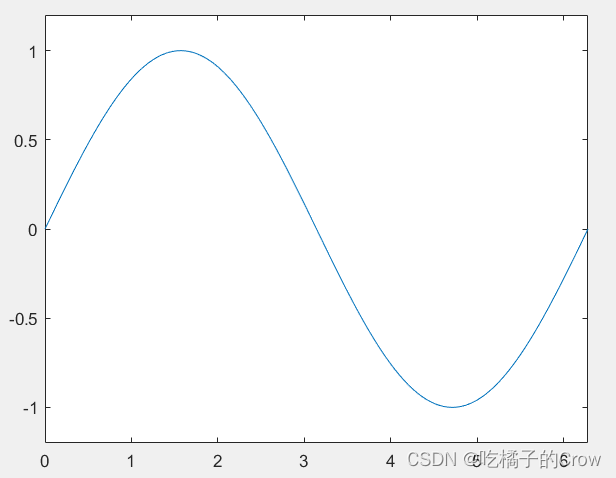
我们已经发现坐标轴已经有了明显的变化
8.2.2 设置轴的字体和刻度
set(gca, 'FontSize', 25);
>> set(gca, 'XTick', 0:pi/2:2*pi);
set(gca, 'XTickLabel', 0:90:360);
8.2.3 修改线条格式以及宽度
>> set(h, 'LineStyle', '-.',...
'LineWidth', 7.0, 'Color', 'g');
我们还可以使用这种方式进行替换:
plot(x,y, '-.g',...
'LineWidth', 7.0);如果我们想删除这个图像怎么操作?
delete(h)
这样是不是和你想的一样呢?
8.3 标记规范
x=rand(20,1); set(gca, 'FontSize', 18);
plot(x,'-md','LineWidth', 2, 'MarkerEdgeColor', 'k',...
'MarkerFaceColor', 'g', 'MarkerSize', 10);
xlim([1, 20]);
9.图像共存
9.1figure
>> x = -10:0.1:10;
y1 = x.^2 - 8;
y2 = exp(x);
%创建两张画布
figure, plot(x,y1);
figure, plot(x,y2);
图像的位置和尺寸:
figure('Position', [left, bottom, width, height]);
示例:
>> figure('Position',[200,300,500,500])
9.2 subplot
那我们可不可以在一张画布中分出几块区域分别进行存储:
subplot(m, n,1);
示例:
>> subplot(2, 2,1);
>> t = 0:0.1:2*pi; x = 3*cos(t); y = sin(t);
subplot(2, 2, 1); plot(x, y); axis normal%还原默认行为
subplot(2, 2, 2); plot(x, y); axis square%使用相同长度的坐标轴线,相应调整数据单位之间的增量
subplot(2, 2, 3); plot(x, y); axis equal%沿每个坐标轴使用相同的数据单位长度
subplot(2, 2, 4); plot(x, y); axis equal tight%将坐标轴范围设置为等同数据范围,使轴框紧密围绕数据
9.3 控制网格、框和轴
| grid on/off | 使网格可见或不可见 |
| box on/off | 使盒子可见或者不可见 |
| axis on/off | 使坐标轴可见或不可见 |
| axis normal | 自动调整轴的长宽和数据单位的相对缩放 |
| axis square | 使当前坐标区域为正方形 |
| axis equal | 设置高宽比,使数据单元在每个方向上都是相同的 |
| axis equal tight | 将轴限制设置为数据的范围 |
| axis image | 图框紧紧地围绕着数据 |
| axis ij | 将坐标系统的原点放在左上角 |
| axis xy | 把原点放在左下角 |
>> box off
grid on%网格
>> axis off%使得坐标轴不可见
10. 将数据保存在文件中


10.1print()
但是我们一般保存文件的时候用的最多的还是print()函数
print('picture','-dpng')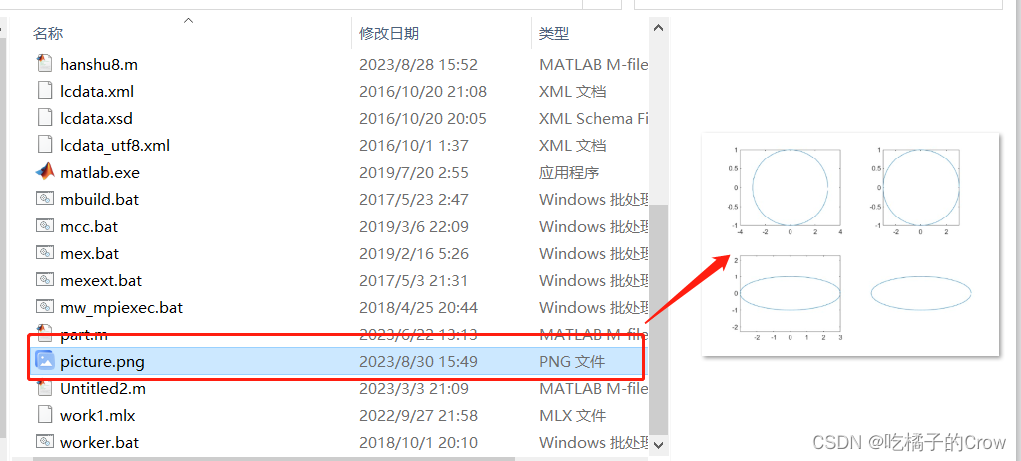
- 语法1:
print(filename,formattype) 使用指定的文件格式将当前图窗保存到文件中,例如 print('BarPlot','-dpng')。如果该文件不包括扩展名,则 print 会附加适用的扩展名。
- 语法2:
print(filename,formattype,formatoptions)%指定可用于某些格式的其他选项。- 语法3:
print('-clipboard',clipboardformat)使用 clipboardformat 指定的格式将当前图窗复制到剪贴板。您可以将复制的图窗粘贴到其他应用程序中
- 语法4:
print(resolution,___)使用指定的分辨率。将分辨率指定为字符向量或字符串,其中包含以 -r 开头的整数值,例如 '-r200'。此选项可与先前语法中的任何输入参数一起使用。

























 3113
3113

 被折叠的 条评论
为什么被折叠?
被折叠的 条评论
为什么被折叠?










